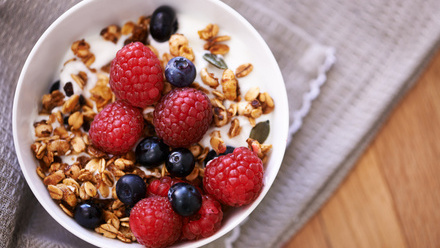What are wholegrains?
A huge variety of cereal crops are grown for food throughout the world. These include wheat, rye, barley, oats and rice. Grains are the seeds of these cereal plants. The entire grain or ‘wholegrain’ contains three elements:
- a fibre-rich outer layer – the bran
- a nutrient-packed inner part – the germ
- a central starchy part – the endosperm

During the milling process, the bran and the germ are often removed to give a ‘whiter’ cereal.
What nutrients do wholegrains contain?
Most of the goodness in grains is in the outer bran layer and germ of the seed so wholegrains can contain up to 75% more nutrients than refined cereals. Wholegrains provide:
- fibre
- B vitamins and folic acid
- essential fatty acids (omega-3 fats)
- protein
- antioxidants including vitamin E, selenium
- micronutrients such as copper and magnesium
- other parts of the plant (phytochemicals) which may have health benefits
Why should we choose wholegrains?
Evidence is growing that eating wholegrains regularly as part of a healthy diet and lifestyle helps to keep us healthy. It may also help to reduce the risk of many common diseases. It is not only the fibre in wholegrains that has health promoting properties - it seems to be the ‘complete package’ of nutrients in wholegrains that work together to offer protection.
Research suggests that:
- The risk of heart disease, stroke and type 2 diabetes may be up to 30% lower in people who regularly eat wholegrains as part of a low-fat diet and healthy lifestyle
- The risk of developing cancer of parts of the digestive system such as bowel cancer may be reduced with higher intakes of wholegrains. Some of the fibre in wholegrains moves food along more quickly and easily, reducing the time that damaging substances are in contact with the gut wall
- Some of the fibre provides a food source for ‘friendly’ gut bacteria. This helps them to increase and produce substances which are thought to protect the gut wall, such as short-chain fatty acids
- Wholegrains may help in maintaining a healthy body weight over time as part of a healthy diet and lifestyle. The fibre in them can help you feel full, and they are digested more slowly, helping you feel fuller for longer
- Wholegrains are usually low in fat but rich in fibre and starchy carbohydrate and often have a low glycaemic index (GI). This means they provide a slow release of carbohydrate into the blood which, together with fibre content, may help keep you feeling fuller for longer - aiding to control snacking and appetite
- Most cereal foods eaten in the UK are refined and our intake of wholegrains is very low. Surveys show that 95% of adults don’t eat enough wholegrains and nearly one in three of us get none at all
How can I increase my intake of wholegrains?
When choosing foods from the starchy food group, replace refined cereal foods such as white bread and rice with wholegrain varieties such as wholemeal bread and brown rice.
Wheat, oats, barley, rye and rice are the most commonly available cereals which can be eaten in the wholegrain form. To find them, look for the word ‘whole’ before the name of the cereal e.g. whole wheat pasta, whole oats and make sure they are high up/ first in the ingredients list. Multigrain is not the same as wholegrain – it means that the product contains more than one different type of grain.
There is currently no advice on what amount of wholegrains to eat in the UK but many experts in other countries say to aim for three servings a day. See the table below for portion size.
List of wholegrains
Cereals
- wheats, including spelt
- rice
- barley including hull-less or naked barley but not pearled
- maize (corn)
- rye
- oats, including hull-less or naked oats
- millets
- wild rice
Other grains
- buckwheat
- quinoa
- ‘ancient grains’ e.g. kamut, freekah, amaranth
Wholegrain foods and ideas for use
|
Type of food |
Wholegrain varieties |
Portion size (one serving) |
Ideas for use |
|
Breakfast cereal |
Whole oats including rolled oats and oatmeal; wholewheat cereals such as wholewheat biscuits, bran flakes, puffed wholegrains, wholegrain muesli; and wholegrain cereal bars |
One tbsp uncooked oats Three tbsp wholegrain cereal |
With milk or yoghurt and fruit for breakfast or as a snack, as a topping for crumbles, as a snack. Choose wholegrain versions with less or no added sugar and salt |
|
Bread and crackers |
Wholemeal, granary, wheatgerm, wholemeal mixed/multi grain or seeded breads (check the label for wholegrains), rye (pumpernickel), wholemeal pitta, wholewheat crackers, oatcakes and rye crispbread |
One medium slice bread Half wholemeal tortilla Half wholemeal pitta Two rye crisp bread Two oatcakes |
Instead of white bread, cream crackers and sweet biscuits |
|
Flour |
Wholemeal, buckwheat, unrefined rye, barley, oatmeal and wholegrain oat flour |
n/a |
In baking or recipes instead of white flour or mixed half and half |
|
Meals |
Brown rice, wholewheat pasta, whole barley (not pearl), bulgur (cracked) wheat, quinoa |
Two to three heaped tbsp cooked brown rice Two to three tbsp wholegrain pasta |
With casseroles, curries, sauces, in soups, and in salads |
|
Snacks |
Wholegrain cereal bars, oat cakes, wholegrain rice cakes, popcorn (plain), wholemeal scones, and wholegrain breakfast cereals |
Half wholemeal scone Two oatcakes Two to three cups/individual bags plain popcorn |
In place of sweets, crisps and savoury snacks, cream crackers and sweet biscuits |
Top tips
- Foods made with whole grains can make an important contribution to our health and wellbeing
- Whole grains include all parts of the grain. Examples of whole grains include brown or wild rice, buckwheat, bulgur, millet, quinoa, rolled oats, wholegrain barley, whole rye, and whole wheat
- Whole grains provide benefits relating to the nutrients (food components) and bioactive compounds (phytochemicals) they contain. These include fibre, protein, vitamins, minerals, anti-oxidants and essential fats
- Evidence is growing that eating wholegrains regularly as part of a healthy diet and lifestyle helps to keep us healthy. Wholegrains may also help to reduce the risk of many common diseases and conditions including heart disease, certain types of cancer, type 2 diabetes, and with weight management
- Most of us eat too few wholegrains as we tend to eat more refined cereals
- When choosing starchy foods, swap refined cereal foods, such as white bread, rice and pasta, with whole grain varieties such as wholemeal bread, brown rice and whole wheat pasta. As well as swapping refined grain products for wholegrain ones, choose wholegrains at mealtimes and as a snack
- To check a product is whole grain, check a whole grain(s) is among the first ingredients listed and look out for the word ‘whole’ as in “wholemeal”, “wholegrain” or “100% whole” as in “100% wholewheat” on the packaging
Source(s)
O'Neill S, Minehan M, Knight-Agarwal CR, Turner M. Depression, Is It Treatable in Adults Utilising Dietary Interventions? A Systematic Review of Randomised Controlled Trials. Nutrients. 2022 Mar 27;14(7):1398. doi: 10.3390/nu14071398. PMID: 35406011; PMCID: PMC9003461.
Schoeneck M, Iggman D. The effects of foods on LDL cholesterol levels: A systematic review of the accumulated evidence from systematic reviews and meta-analyses of randomized controlled trials. Nutr Metab Cardiovasc Dis. 2021 May 6;31(5):1325-1338. doi: 10.1016/j.numecd.2020.12.032. Epub 2021 Jan 16. PMID: 33762150.
Reynolds A, Mann J, Cummings J, et al. Carbohydrate quality and human health: a series of systematic reviews and meta-analyses. Lancet 2019. doi:10.1016/S0140-6736(18)31809-9.
Chambers ES, Byrne CS, Frost G. Carbohydrate and human health: is it all about quality?Lancet 2019. doi:10.1016/S0140-6736(18)32468-1
Third Expert Report: World Cancer Research Fund/American Institute for Cancer Research. Diet, Nutrition, Physical Activity and Cancer: a Global Perspective. Continuous Update Project Expert Report 2018
Whole grain and refined grain consumption and the risk of type 2 diabetes: a systematic review and dose-response meta-analysis of cohort studies. Eur J Epidemiol . 2013 ; 28 :845–858. doi: 10.1007/s10654-013-9852-5.
Zong G, Gao A, Hu FB, Sun Q. Whole Grain Intake and Mortality From All Causes, Cardiovascular Disease, and Cancer: A Meta-Analysis of Prospective Cohort Studies. Circulation. 2016;133:2370-80. http://www.ncbi.nlm.nih.gov/pubmed/27297341
Aune D, Keum N, Giovannucci E, et al. Whole grain consumption and risk of cardiovascular disease, cancer, and all cause and cause specific mortality: systematic review and dose-response meta-analysis of prospective studies. BMJ. 2016;353:i2716. http://www.ncbi.nlm.nih.gov/pubmed/27301975
Wu H, Flint AJ, Qi Q, et al. Association between dietary whole grain intake and risk of mortality: two large prospective studies in US men and women. JAMA Intern Med. 2015;175:373-84. http://www.ncbi.nlm.nih.gov/pubmed/25559238
Anderson JW (2003) Whole grains protect against atherosclerotic Cardiovascular Disease. Proceedings Nutrition Society 62
Aune D et al(2011) Dietary fibre, whole grains, and risk of colorectal cancer: systematic review and dose-response meta-analysis of prospective studies BMJ 2011;343:bmj.d6617
Lang R and Jebb SA (2003) Who consumes whole grains and how much? Proceedings Nutrition Society 62:123-127
Slavin J, Jacobs D, Marquart L & Wiemar K (2001)The role of wholegrains in diseases prevention. JADA 101(7):780-785
Steffen LM et al (2003) Associations of whole-grain, refined-grain and fruit and vegetable consumption with risks of all-cause mortality and incident coronary artery disease and ischaemic stroke: the Atherosclerosis Risk in Communities (ARIC) study. American Journal Clinical Nutrition 78: 383-390
Venn BJ and Mann JL (2004) Cereal grains, legumes and diabetes. European Journal Clinical Nutrition 58: 1443-1461







